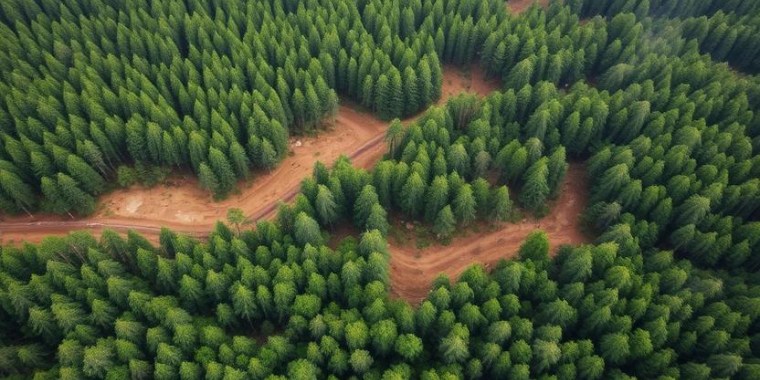Your Guide to Forest Trends: Tracking the Shifts That Shape Our Planet

You might think a forest is just a combination of trees, but it's much more than that. Naturally, we consider them non-living things, but they are living ecosystems that store carbon, regulate rainfall, filter the air, and support wildlife. This is why when forests change, the climate changes with them.
Even human survival is deeply tied to the state of the world's forests. Yet every year, millions of hectares are lost to fires, droughts, illegal logging, and shifting land use. These trends tell us where we're headed and the actions needed to sustain life.
The Disappearing Forest: Deforestation in Real Time
The most obvious trend in many parts of the world is deforestation. According various parts of the world, you'll discover several trees cut down for farmland, development, mining, and infrastructure.
According to Global Forest Watch, the world lost over 4.1 million hectares of tree cover in tropical primary forests in 2022 alone. Such a figure is hard to ignore as it deals a critical blow to biodiversity and carbon storage capacity.
Rainforests in the Amazon, Congo Basin, and Southeast Asia are the hardest hit. Illegal logging, poorly regulated agricultural expansion, and weak governance all play a role. Once a forest is cleared, it rarely grows back the same. Even if trees return, the ecosystem loses many of its original species and resilience.
What's more interesting is how the trend also indicates a rapid increase in these losses. Forests are vanishing faster than they can regenerate, and many of the ecosystems replacing them are far less stable.

What's Causing the Shift?
Look around and you'll notice that the forces behind forest loss are rooted in human decisions and environmental stressors. But once we understand the driving factors responsible for these shifts, slowing down the trend, and protecting what remains becomes much more possible.
Below are the primary culprits reshaping the world's forest landscapes.
1. Agricultural Expansion and Logging
We've highlighted the adverse effect of deforestation, and its biggest driver is still land use. Forests are being cleared for soy farms, palm oil, beef, and timber.
In countries like Brazil, Indonesia, and the Democratic Republic of Congo, weak land governance allows illegal logging and encroachment on protected areas. Most of this is profit-driven and short-term.
2. Climate-Induced Wildfires
There was once a time when wildfires were seasonal. Now they're year-round. Hotter temperatures and dry air create flammable forests, while lightning strikes or human carelessness ignite them. In 2023, wildfires in Canada alone burned over 18 million hectares, setting a national record.
While these fires consume and destroy trees, they also release stored carbon, creating feedback loops that intensify climate change.
3. Drought and Water Stress
Just as we humans need to stay hydrated, forests need water too. Sadly, droughts are cutting off the supply. That explains why we have so many trees under water stress that become vulnerable to disease, pests, and eventual die-off.
In the western United States, millions of pine trees have died from bark beetle infestations. The major trigger for these issues is often due to drought conditions that weakened their natural defenses.
The Climate Connection
The condition of the forest naturally plays a significant role in the climate. Trees absorb carbon, which slows warming. But when they burn, die, or get cut down, they release that carbon back into the atmosphere.
The Amazon used to be a key carbon sink, preventing its release into the atmosphere. Unfortunately, it now emits more carbon than it absorbs in some regions. At this point, it's no longer a future threat; it's already happening.
Pockets of Progress
While global trends are not looking encouraging, some regions are reversing the damage:
- Costa Rica doubled its forest cover in under 30 years through strict conservation laws and eco-tourism incentives.
- Ethiopia eclipsed its previous world record by planting 560 million trees in one day—12 hours precisely.
- India has invested in urban forests to counteract extreme heatwaves and air pollution on public health.
These examples show that restoration is possible when governments, communities, and scientists work together with long-term plans.
Technology Is Changing the Game
We've now come a long way in innovations and technological advancements, which make it possible to track forest loss and gain in near real-time. The development of several tools is helping conservationists respond faster, enforce protections better, and plan restoration more efficiently.
- These tools include:
- Global Forest Watch (satellite-based alerts)
- NASA's GEDI Lidar (3D forest structure mapping)
- AI-driven drone surveillance
How This Affects Everyone
The idea that forest loss only affects the environment could not be further away from the truth. It connects to other parts of human life, such as:
- Health: Smoke from wildfires travels thousands of miles, worsening asthma, heart conditions, and lung diseases.
- Food Security: Forests regulate rain and pollinators. Their collapse increases the risk of crop failure.
- Water Supply: Forests store and filter water. In some areas, deforestation has already led to water scarcity downstream.
- Indigenous Rights: Many forest communities are being pushed off ancestral lands by deforestation, losing not just homes but centuries of cultural knowledge.
Ignoring forest trends means ignoring human suffering, climate breakdown, and rising instability.
How Can We Do Better?
Several countries are already taking steps to reduce the damage to the forest to mitigate its effects on the community at large. There are clear ways to reduce pressure on the forest and ensure last recovery. Here's where we start making change count:
1. Rethink Consumption
Consumer demand is a major factor driving deforestation. From beef to palm oil to fast furniture, our choices shape supply chains. We can play our part by choosing certified sustainable products, which will invariably send signals that reach all the way back to the forest floor.
2. Support Forest Governance
Many forest-rich countries lack enforcement power. Strengthening legal protections, supporting indigenous land rights, and funding local ranger systems is often more effective than global pledges or carbon offsets alone.
Final Words
It's not by accident that forests are changing faster than ever. As mentioned, deforestation, fire, drought, and human activity are accelerating ecosystem breakdown. But they're not beyond saving. The trends we track today will determine what kind of forests the next generation inherits. The canopy is trying to tell us something. It's up to us to listen, and act.



